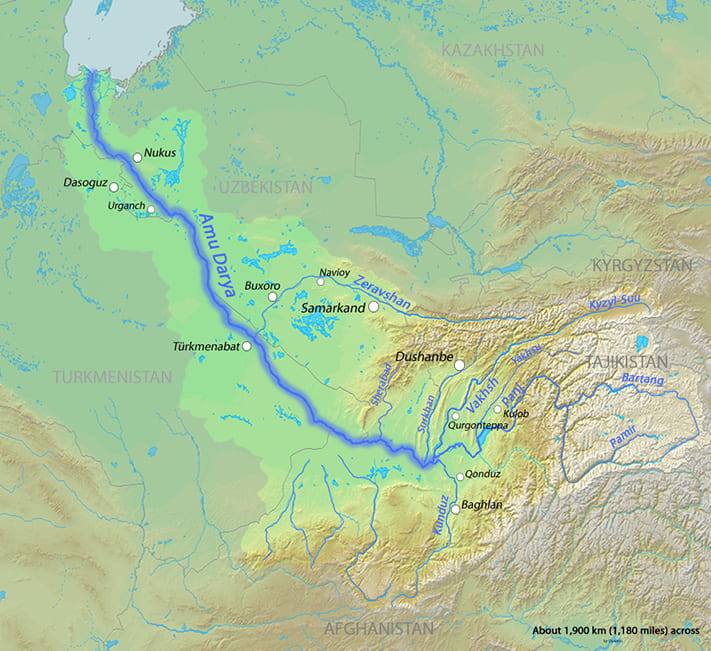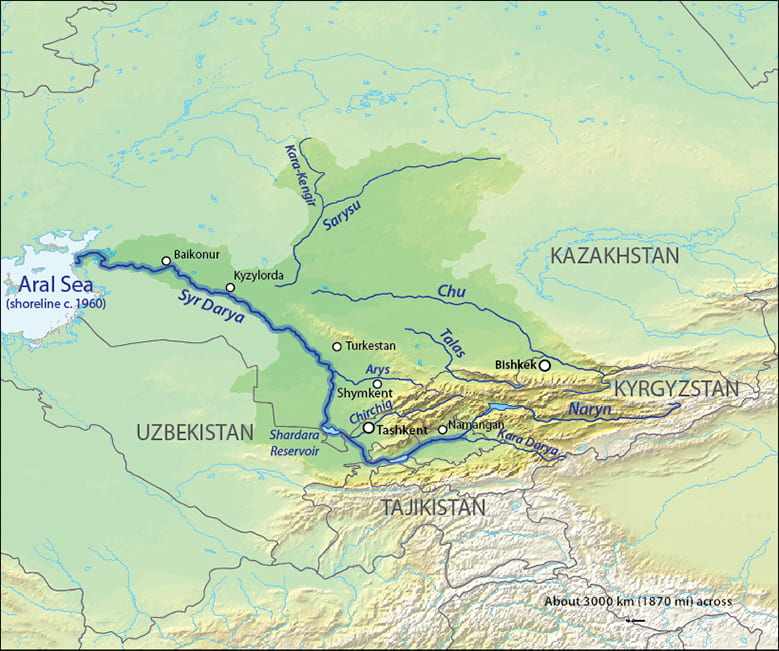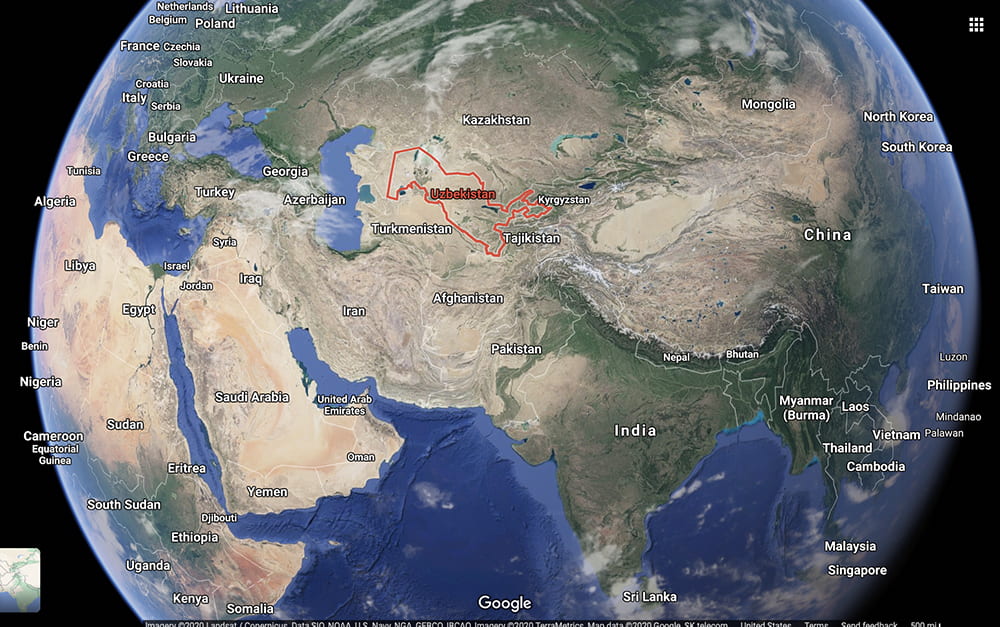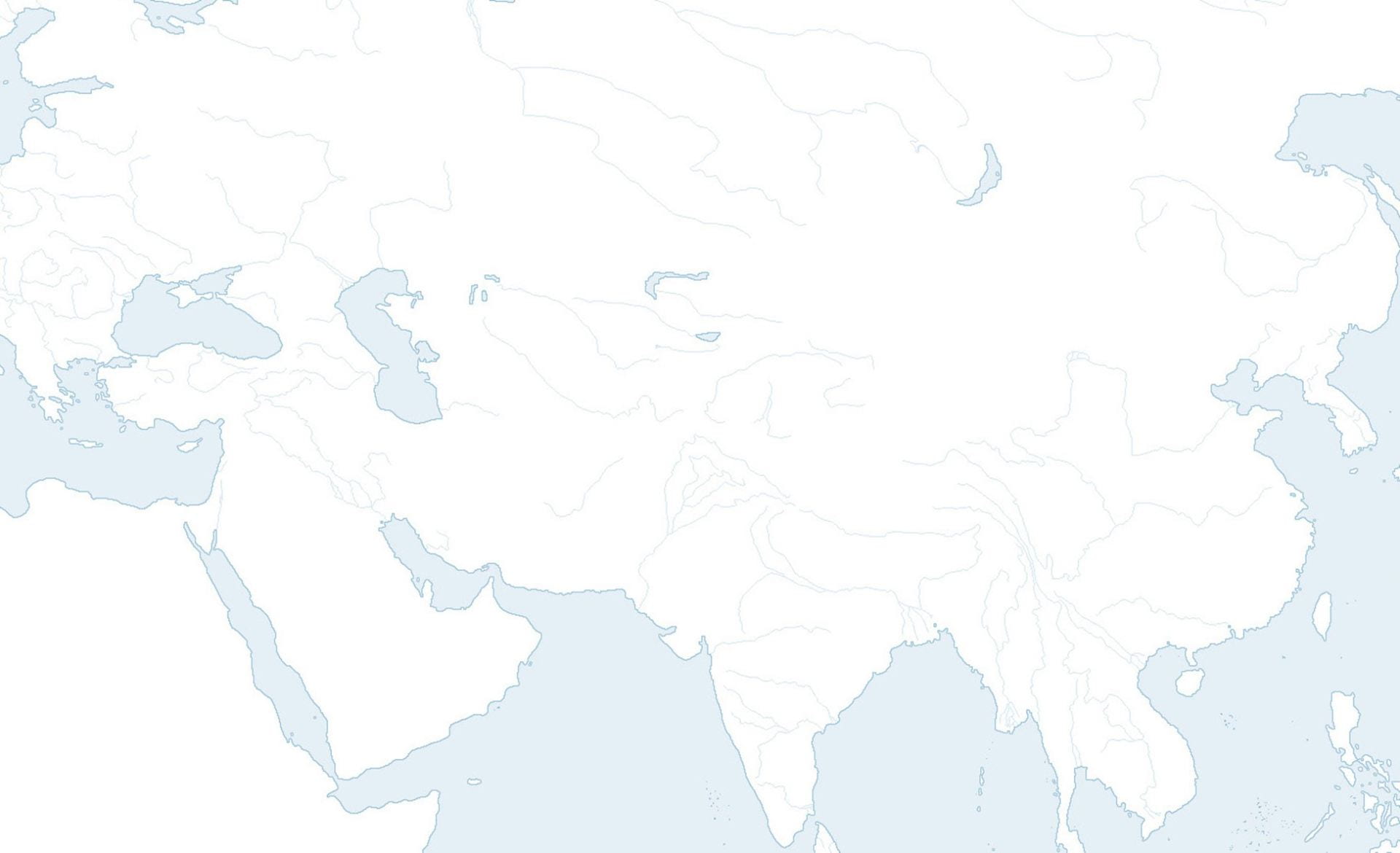Overview
In this module, we present a long-term history of the territory that is Uzbekistan today. Much of what we cover is general Central Asian history and does not conform to the modern boundaries of today’s Uzbekistan, which were established in 1991. Nonetheless, this quick glance at the county’s deep past shows how closely connected this region was with major world historical processes, such as the spread of world religions across the Silk Road, the blossoming of medieval Islamic science and the development of early modern trade.
Accordingly, the module divides this complicated history into three parts. Similar to how Western civilization history courses are usually divided into the antiquity of the Greeks and Romans, a medieval period and a modern period, we have divided Uzbekistan’s past into three major periods as well. In the first selection, we cover the ancient period with a focus on non-Western religions and cross-cultural interaction along the Silk Roads. During this period, the land that is Uzbekistan today was called Sogdiana, named after the famous Sogdian merchants. In the second part, we will learn about the Islamic history of the land that is today Uzbekistan. During this period, the region was called Mā warā’ an-nahr, an Arabic word meaning “the land beyond [the Oxus] river.” Although this term was first used by Islamic historians, it was also used by local writers as well. Earlier this region was called Transoxiana, “beyond the Oxus river,” by the Greeks, which has a similar meaning to Mā warā’ an-nahr. In this section, we focus on cultural and intellectual achievements. In the third section, we focus on the integration of Mā warā’ an-nahr into processes of early-modern globalization as we move towards the Uzbekistan of today.
The three sections each emphasize different themes and can be used separately or together. In addition to the three historical sections, resources pertaining to the modern history of Uzbekistan and current events are listed at the bottom of this page after the further reading and resources section.
 Uzbekistan and Surrounding Countries
Uzbekistan and Surrounding Countries
Part One: Antiquity: Silk Roads and World Religions
Part Two: Islamic Culture in the Medieval Period
Part Three: Globalization and Modernity
List of Key Terms
Amu Darya River — one of Central Asia’s main rivers, originating in the high mountains of Tajikistan, it runs along the border between Uzbekistan and Afghanistan, through northeastern Turkmenistan and then along the border between Turkmenistan and Uzbekistan, and eventually flowing into the deltas leading to the Aral Sea to the north of Nukus in the Karakalpakstan province.
 The Amu Darya river (the highlighted area is the river’s watershed)
The Amu Darya river (the highlighted area is the river’s watershed)
Syr Darya River — Central Asia’s second major river, originating in the mountains of Kyrgyzstan and eastern Uzbekistan, it flows west and then northwest, crossing through southern Kazakhstan, eventually reaching the northern part of the Aral sea.
 The Syr Darya river (watershed highlighted)
The Syr Darya river (watershed highlighted)
Sogdiana — also called Sogdia, originally a province of the Achaemenid empire (559-334 BCE), the homeland of the Sogdian merchants. Although scholars are still debating exactly how they would have referred to themselves, the word Sogdian comes from the Avestan sugda or the Old Persian suguda.
Sogdian merchants — the original Silk Road traders and key cultural intermediaries, connecting many different cultural zones in Eurasia during antiquity.
Mā warā’ an-nahr — “the land beyond [the Oxus] river” in Arabic, roughly the land between the Amu Darya and the Syr Darya rivers, sometimes called Transoxiana, which is Latin for “the land beyond the Oxus River.” The Oxus is what the Greeks called the Amu Darya River. For a map see Part Two: Islamic Culture in the Medieval Period.
Khan — sometimes spelled qaghan, or khaqan, the leader of a confederation of mobile pastoralist tribes in Central Eurasia.
Khanate — the Central Asian equivalent of a kingdom, except with a Khan as its highest ruler.
Nisba — an additional name indicating a tribe, area, or profession to which an individual belonged usually ending in ī. For example, al-Bīrūnī, the famous scientist, was from the bīrūn (a region kind of like a pre-modern suburb) of Kath.
Sufi (sufism) — a form of mystical Islam, which became popular in Central Asia starting in the eleventh century CE.
Syncretism — when two religions coexist within the same community, or when two religions fuse together into a new hybrid religion. Examples of syncretism in this module include Chistian-shamanism, shamanistic Islam and the convergence of Buddhism with Near Eastern religions in Manichaeism.
Turkic — as an ethnic group, this word means descendent from the first Türk empire in Mongolia (553-682 CE); as a linguistic term it means belonging to the Turkic languages, which include modern Turkish, Uzbek and many other languages from across Eurasia, for more on language see the Language (Til) section.
Mobile pastoralism — sometimes called “nomadic pastoralism” or “nomadism,” refers to economies that are dominated by products produced by pasture or grasslands, such as horses, sheep, camels, or other animals, as well as trans-regional trade. Although the mobile pastoralist economy is often diverse and sometimes includes aspects of agricultural production, mobile pastoralist societies are characterized by a high-level of mobility.
The Silk Roads — a complex network of trade routes stretching across Eurasia connecting Europe, China, the Middle East and India.
Suggested Learning Activities
Map Game (1-2 class periods)
Fill in this blank map with the four most important features of Central Asian/Uzbek history. Features can include cities, rivers, mountains, archaeological monuments, or other locations. This activity can be paired with the Nature (Tabiat) section of this module. Let the students decide which ones are the most important and have them reflect on their choices.
Religions on the Silk Road (1-2 class periods)
Divide the students into seven different groups and assign each group one of the following religions:
- Zoroastrianism
- Judaism
- Buddhism
- Nestorian Christianity
- Manichaeism
- Shamanism
- Islam
Have each group work together to form a short group report answering the following three questions:
- Where does this religion come from and how did it get to Central Asia/Uzbekistan?
- Where are its main beliefs?
- What role did it play in Central Asian/Uzbek history?
Students can use the texts on the religions given above as well as their own internet explorations. (Instructors: keep in mind that not all information on the internet is true or reliable). When each group is ready, have them present what they have learned to the whole class.
Picture/Object Game
Put any of the pictures in this module in front of your students and have them guess about what they think it could be and what it could mean. Have them imagine that they are anthropologists, and they need to reconstruct the society that created the image/object. Slowly work through their assumptions and guesses directing then towards a full contextualization of the object or image. After entertaining some of their ideas and possibilities explain in detail what the object, building or painting is and what it tells us about the past.
Further Reading and Resources
General Surveys
- For an overview of Central Asian history see History of the Civilizations of Central Asia, an open-source multi-volume book written by a team of historians from across the globe, published by UNESCO (bottom of the page): https://en.unesco.org/themes/generalregionalhistories#centralasia
- The brief summary of the history of religions given in Part One above follows Richard Foltz’s Religions of the Silk Roads: Premodern Patterns of Globalization, for a longer version of this story see Volume 3 (chapters 17-19) of the UNESCO History linked above.
- Svat Soucek, A History of Inner Asia (Cambridge: Cambridge University Press, 2000).
- Scott C. Levi and Ron Sela, Islamic Central Asia: An Anthology of Historical Sources, (Indiana University Press, 2009).
Historical Architecture
- https://theculturetrip.com/asia/uzbekistan/articles/exploring-the-architectural-treasures-of-samarkand/
- https://www.orientalarchitecture.com/cid/225/uzbekistan/bukhara
Historical Pictures
- https://www.metmuseum.org/art/collection/search#!/search?geolocation=Bukhara
- https://www.metmuseum.org/art/collection/search#!/search?geolocation=Uzbekistan&perPage=20&searchField=All&sortBy=Relevance&offset=0&pageSize=0
Murals from Afrosiob
More about Afrosiob
Ancient History
- Rozwadowski, Symbols through Time: Interpreting the Rock Art of Central Asia (Poznań: Institute of Eastern Studies, University of Adam Mickiewicz, 2004).
- Rozvadowski and M. M. Kośko (eds.,) Spirits and Stones: Shamanism and Rock Art in Central Asia and Siberia (Poznań: Instytut Wschodni UAM, 2002).
- A Sogdian Buddhist manuscript:http://www.orientalstudies.ru/eng/images/pdf/a_livshits_1996.pdf
- A list of Buddhist sites in Central Asia:http://www.orientarch.uni-halle.de/ca/bud/litera.htm
- Janos Harmatta, “Religions in the Kushan Empire,” in History of the Civilizations of Central Asia, vol. 2 Paris: UNESCO, 1994.
- A website about the role of Sogdian merchants as trans-cultural communicators: https://sogdians.si.edu/believers-proselytizers-translators/
- A resource for Silk Road maps: http://www.orgs.miamioh.edu/silkroad/maps/maps.html
- Website on the Sogdian letters: https://sogdians.si.edu/ancient-letters/
- A study of Silk Road food: https://journals.plos.org/plosone/article?id=10.1371/journal.pone.0045137
- A study of historical food in Uzbekistan: https://journals.plos.org/plosone/article?id=10.1371/journal.pone.0201409
- An article about archaeology in Uzbekistan: https://source.wustl.edu/2017/07/target-excavating-leads-lost-city/
- Follow this link for a lecture about Turkic and Steppe history in the 6th and 7th centuries and its connections with Byzantium and China by Professor Preiser-Kapeller: https://www.youtube.com/watch?v=ZRbKVecxzn0
Medieval History
- Gohlman, William E., (trans.,) The Life of Ibn Sina: A Critical Edition and Annotated Translation. Albany: State University of New York Press: 1974.
- Dilfuza Djamalinovna Buranova, “The Value of Avicenna’s Heritage in Development of Modern Integrative Medicine in Uzbekistan”, Integrative Medicine Research 4, no. 4 (December 2015): 220-224.
- Nicholas Seay, “Ibn Sina as Corona Meme: The Internet Afterlife of a 1950s Soviet Film” Ajam Media Collective published online April 16, 2020.
- A movie about Ibn Sina: https://www.rottentomatoes.com/m/the_physician_2014
- An image of the Uyghur script Qutadgu Bilig poem written during the Qarakhanid period: https://upload.wikimedia.org/wikipedia/commons/1/1f/QutadughuBiliq_wien_p.10.jpg
- A BBC discussion of al-Biruni: https://www.youtube.com/watch?v=dYedbOuATng
- A list of al-Biruni’s works with online links: http://www.jphogendijk.nl/biruni.html
- Frederick Starr, Lost Enlightenment: Central Asia’s Golden Age From the Arab Conquest to Tamerlane (Princeton: Princeton University Press, 2013).
- A blog post about Ulug Beg: http://riowang.blogspot.com/2013/03/astrolabes-astronomers-observatories.html
- A short article about Ulug beg’s legacy: http://vlib.iue.it/carrie/texts/carrie_books/paksoy-2/cam6.html
- A comparison between Ptolemy and Ulug Beg: https://www.aanda.org/articles/aa/pdf/2012/08/aa19596-12.pdf
- Timur era art: https://www.metmuseum.org/toah/hd/timu/hd_timu.htm
- About Babur’s life: https://depts.washington.edu/silkroad/texts/babur/babur1.html
- Many primary sources for Central Asian history are written in a language usually called Chaghatay. It is quite similar to modern Turkic languages, especially Uzbek and Uyghur [a Turkic language spoken by at least twelve million people in China’s Xinjiang province]. A textbook for learning this language by Eric Schluessel is now available in paperback: Eric Schluessel, An Introduction to Chaghatay: A Graded Textbook for Reading Central Asian Sources (Ann Arbor: Michigan Publishing Services, 2018).
Uzbekistan Today!
After working through this module you may be wondering about what is going in Uzbekistan today. Although we didn’t cover much about the modern history of Uzbekistan, here are some useful resources and links that cover contemporary history and current events:
Books
- Adeeb Khalid, Making Uzbekistan: Nation, Empire, and Revolution in the Early USSR (Cornell University Press, 2015).
- Marianne Kamp, The New Woman in Uzbekistan: Islam, Modernity, and Unveiling under Communism (University of Washington Press, 2008).
- Abdullah Qodiriy, Bygone Days: O’tkan Kunlar (Bowker, 2019), translated by Mark Reese.
- Abdülhamid Sulaymon o’g’li Cho’lpon, Night and Day: A Novel (Academic Studies Press, 2019), translated by Christopher Fort.
Websites
- A website covering current affairs in Uzbekistan and across Central Asia:https://voicesoncentralasia.org
Websites for News About Uzbekistan
- https://kun.uz/en
- https://www.theguardian.com/world/uzbekistan
- https://eurasianet.org/region/uzbekistan
- https://tashkenttimes.uz
- https://www.bbc.com/news/topics/clm1wxp5pzwt/uzbekistan
- https://www.aljazeera.com/where/uzbekistan/
- https://www.independent.co.uk/topic/uzbekistan
- https://www.euronews.com/news/asia/uzbekistan
- http://www.uzdaily.uz/en
Other
- A recently established resource about Central Asia and Uzbekistan: https://oxussociety.org/publications/channels/
- The Central Eurasian Studies Society holds yearly conferences and is a good resource for Central Asia related topics: https://www.centraleurasia.org
- The Silk Roads are still important for Uzbekistan today in terms of business, tourism, and even geopolitics. Follow this link for a story map of the Silk Roads by National Geographic that includes coverage of the “New Silk Road”: https://storymaps.esri.com/stories/2018/silk-road/index.html
- The Majlis podcast provides news coverage related to Uzbekistan and the other Central Asian states: https://www.rferl.org/z/19887
- An interview with Mark Reese: https://newbooksnetwork.com/abdullah-qodiriy-bygone-days-bowker-2019
- An interview with Christopher Fort: https://newbooksnetwork.com/abdulhamid-sulaymon-ogli-cholpon-night-and-day-a-novel-academic-studies-press-2019
Articles
- An article about Uzbekistan’s melon exporting economy: https://central.asia-news.com/en_GB/articles/cnmi_ca/features/2017/11/13/feature-01
- An article about retail in Uzbekistan: https://www.eurasianinvestor.com/analysis-articles/2019/9/12/retail-revolution-comes-to-uzbekistan
- An article about economic changes during the Covid-19 pandemic in Uzbekistan: https://uk.reuters.com/article/us-health-coronavirus-uzbekistan-retail/as-pandemic-empties-traditional-uzbek-bazaars-supermarkets-step-in-idUKKBN22C1SU
- A 2019 assessment of Uzbekistan’s economy: http://documents1.worldbank.org/curated/en/866501562572675697/pdf/Uzbekistan-Toward-a-New-Economy-Country-Economic-Update.pdf
- An assessment of economic modernization: https://isdp.eu/publication/economic-modernization-uzbekistan/
- An article about produce in Uzbekistan: https://www.worldbank.org/en/news/feature/2017/11/14/loans-helping-uzbek-farmers-sell-more-of-the-best-fruits-and-vegetables-in-the-world
- An article about the Uzbek writer Abdullah Qodiriy: https://voicesoncentralasia.org/the-uzbek-modernist-abdullah-qodiriy-a-writer-and-his-novel/
- An article about changes in the media in Uzbekistan: https://thediplomat.com/2020/04/uzbekistans-changing-media-space/
- A review of Tashkent’s subway: https://www.nytimes.com/2019/11/20/travel/tashkent-uzbekistan-subway.html



